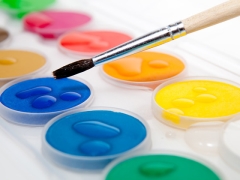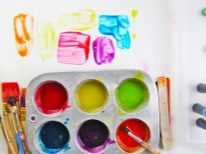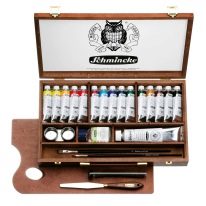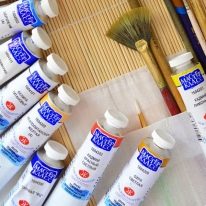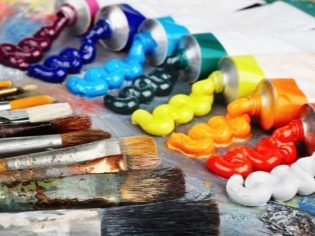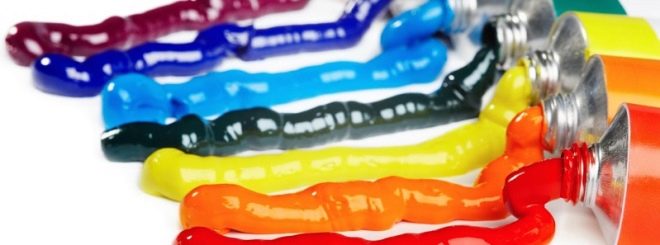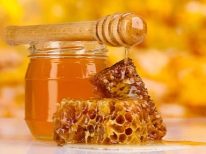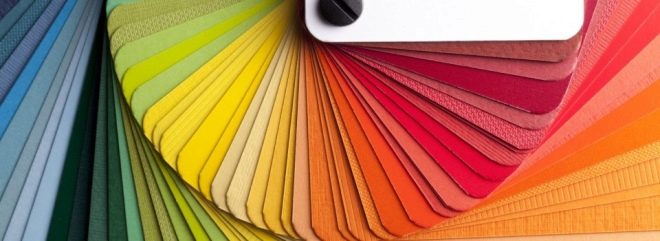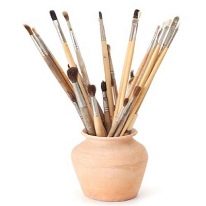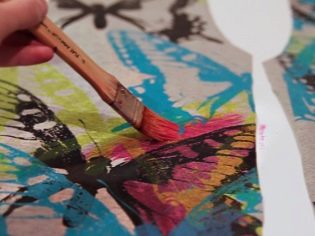Paint for drawing: types and characteristics
Drawing is a favorite form of children's creativity. It is with the help of brushes and paints that they can convey their fantasies, even if they still cannot really speak. And any mother will take care of choosing the right inventory for her child for creative work.
Story
Paint for drawing there are more than one millennium. Even in ancient times, people used the paint of the simplest structure. So, some plants can stain the skin and other surfaces. Ancient people used it, creating the first drawings. At their disposal were various mineral pigments, clay, soot. The first paints they received from ocher. In its pure form it was used to make mixtures of light shades, and to create darker ones, charcoal was added.
Later, the paint began to receive with the help of animal fats. Over time, our ancestors experimented with mixing different substances. About five thousand years ago cinnabar appeared, by means of which they obtained the red color. Purple paint appeared in Egypt. Lime is used to produce white. In ancient China, watercolor paints were created, and the Middle Ages - this is the time of the appearance of oil paints.
Over time, the technology of manufacturing paints has not changed much, but the process is improving, new shades, compositions and areas of their application appear.
Kinds
There are quite a lot of application areas for paints, so a variety for a particular job is chosen according to the goals. Select several types.
Baby
In the first place to children's paint should include:
- watercolor. This type is designed for drawing on paper. Watercolor paints are environmentally friendly and have a wide range of colors. Drawings turn out bright, easy. Watercolor artists use to create sketches or small sketches, illustrations, and kids are used to working with these paints in kindergarten, school or at home;
- fingertips It can be used from an early age when the baby still does not know how to hold a brush, and he still does not care about the quality of the drawing. The main thing is vivid impressions. A child with these paints has the ability to do right hands: dip a finger in water, then paint and smear on paper. In the composition of harmless food colors, having a taste that will discourage the crumbs of the desire to try this paint;
- gouache. This type is similar to watercolor. Gouache can fix unforeseen defects in the pattern, create three-dimensional images. The difficulty of use may be that it will be difficult to achieve a smooth tone of color. Dry paint is diluted with water before use.
Professional
As professional art materials (besides watercolor and gouache paint) several more varieties are used:
- acrylic. They have bright colors, do not fade, are waterproof, do not fade in the sun, and after drying do not change color and do not form cracks. Available in thick and liquid acrylic. Paint a thick consistency, you can create interesting textures;
- oil. It has a thick texture, is available in tubes. This type of paint for artists with experience, requires certain skills and time. Oil paints create the most realistic images of man and nature by obtaining three-dimensional images;
- tempera. These paints are durable and can not be washed off with water after drying, but over time they can start to lose color.When applying, you can use any technique, combined with other paints. They put tempera on paper, wood, canvas, cardboard, glass, plaster and even concrete;
- sanguine and sepia. The use of this type of paint is reminiscent of chalk drawing, as it is produced in small crayons. It can be used to depict nudes, because the color is similar to the tone of human skin. These non-staining paints are easy to apply and feather;
- pastel. Gives the picture some fabulousness. Available in the form of crayons. Easy to use.
There are types of paints for drawing with a marker. This is a marker paint. When applied to the surface, a coating is created that can be used as a board for drawing with a water-based marker. It is easily washed with a dry cloth or sponge.
There are neon colors that glow in the dark. Apply on concrete, wood, plaster, fabric and other bases. The scope of this material is very wide: interior design, outdoor advertising, various warning signs.
Fans of graffiti for a long time "on you" with paint in cans. With its help, you can create bright art images on the walls of buildings. In cooking, food dyes are used to decorate desserts, for example, to paint a cake on a glaze.
Composition
The chemical composition of all paints includes four main elements:
- dye (pigment);
- binder;
- filler;
- solvent.
To obtain different colors using several pigments:
- white (chalk, lime);
- green (lead, chromium);
- yellow (ocher, kroner);
- red (cinnabar, minium);
- blue (azure, ultramarine).
To create paints, both natural and artificial pigments are used. Among natural distinguished mineral and organic dyes.
Mineral are highly durable and lightfastness. They go well with binders. These pigments are mined from metals and oxides. Color examples:
- purple (manganese);
- blue (cobalt, ultramarine);
- brown (van dik, umber, iron oxides);
- yellow (antimony, ocher, manganese);
- red (oxides of copper and iron, ocher when calcined).
Organic dyes are obtained from plants and insects. These pigments are less durable, dissolve in water, alcohol, in oils. Artificial pigments are characterized by good resistance to moisture, light, gases. These dyes have bright pure colors, therefore, are more popular than natural. As binders, eggs and clay were previously added. Now various hardening oils, polymers, resins are added to them. Thanks to the bonding elements, the paint forms a film when dry:
- Fillers are needed paints to modify their texture and dullness;
- Solvents are needed to make it easier to use paints in the work: a less viscous composition is easier to collect on the brush and applied to the surface.
The composition of watercolors include water, vegetable gums, honey or sugar. Watercolor refers to the number of washable paints, especially if the drawing was applied to the glass. The same applies to gouaches, whose composition is close to watercolor. It differs only in that special whitewash has been added to the gouache, due to which the dried-up pattern becomes velvety.
The basis of oil paints most often is linseed oil. The composition of indelible tempera paints includes a water-soluble base, one of the components of which is egg yolk.
The binding element of acrylic paints is a polymeric substance. Acrylic also refers to the number of non-washable materials.
Colors
Nowadays, manufacturers offer a wide selection of various shades. Watercolor, pastel, tempera and gouache paints have an extensive color range: white, red, yellow, blue, black, green, brown and other shades. Wherein, if the set does not have the color you need, you can always mix the palettes and get the necessary.
Gouache is made of two types: artistic and poster.The second one has brighter shades, and the first is used by professionals to create realistic images. Among the wide selection of colors tempera paint can be found specimens with sparkles. Pearlescent brilliant shades are found in an assortment of acrylic paints.
Required Tools
For the creative process of drawing is not enough sheet of paper, pencil and paint. Need to stock up on the necessary supplies. What other items are needed?
Some use for convenience the tablet - a small wooden board to which a sheet of paper is attached. The tablet can be used to, for example, not damage the table, or if it is inconvenient to work at the table and you want to place a small “canvas”, say on your lap.
Be sure to get quality brushes of different sizes. For their rinsing need a glass of water. If the artist uses oil paints, you will need a solvent to wipe them off your hands or arms. Also a necessary tool of the artist is the palette, which is needed to mix colors and get new shades. An experienced and experienced artist will need a good canvas and easel for work, and for a finished, dried picture, lacquer may also be useful to protect the surface.
Application
If there is a craving for drawing, application of artistic talent is easy to find. Moreover, in our time there are so many possibilities. The simplest is to draw on paper. Often this is done for the soul, to escape from heavy thoughts or to some extent relax. A sheet of paper - material for creating sketches, sketches. Also paper is a way to practice for beginning artists.
On the canvas, paintings are painted by experienced artists, masters of their craft, as well as students of special educational institutions with artistic orientation. Painting on wood is a great way to pass the time, as well as give an ordinary thing originality. For example, a painted pencil holder will decorate a boring desktop.
When creating an interior design, you can give free rein to your imagination and paint the walls of an apartment in the hallway, bedroom or bathroom. In the latter case, use indelible paint. You can also revive the interior with your own picture, but not on the walls, but on the canvas. A bored housewife with a talent of the painter could do drawing on the fabric, and then place the finished work in a beautiful frame and hang it on the wall.
It would be interesting to use luminous paints in the interior. It would look very impressive. You can paint clothes with the same colors, especially if you want to update your wardrobe with a pair of stylish T-shirts, but there is no usual way to do it. Interesting colorful patterns can be applied to dishes. It is especially good to do this with the whole family or mother with children. It is not necessary to remind you how important joint work is for rallying family members, especially creative ones.
The usual thing was painting on glass. Pictures on the windows in large numbers appear in the winter season (on New Year's Eve), when you want to decorate your home with something special. This applies not only to residential buildings, but also, for example, schools, kindergartens. In the past 15–20 years, body art has become a particularly popular form of art. The human body acts as a canvas, and the main idea of the image is achieved with the help of gestures, postures, and applied signs.
A completely harmless variation of this form of painting, which children love so much, is face painting or face-painting. Literally within a few minutes, the child turns into a kitten, tiger cub, hare, or simply enjoys a beautiful pattern on the face.
How to choose?
Good quality paint will not be too cheap and of unknown origin. Refer to well-known manufacturers who will not risk reputation, saving on product quality.
Good paints should not have a strong odor, should not be dried. If you choose them for the child, carefully read the composition. Toxic substances must be absent.
Pay attention to shelf life. Overdue paint will not work.
The choice of color depends on the purpose of use. If you need realistic pictures and vivid images, then natural, saturated, but not flashy bright colors will do. If you create something in the spirit of modern, bright acrylic, neon shades will suit you. As for children, it is better to start with a small number of flowers, gradually increasing their number with age (4, 6, 12, 20).
If you want your child to seriously engage in your favorite creative work or decide to join the painting yourself, do not skimp on the materials, get everything you need, recharge yourself with a good mood and create joy to yourself and others.
For information on how to choose the right materials for drawing, see the following video.
